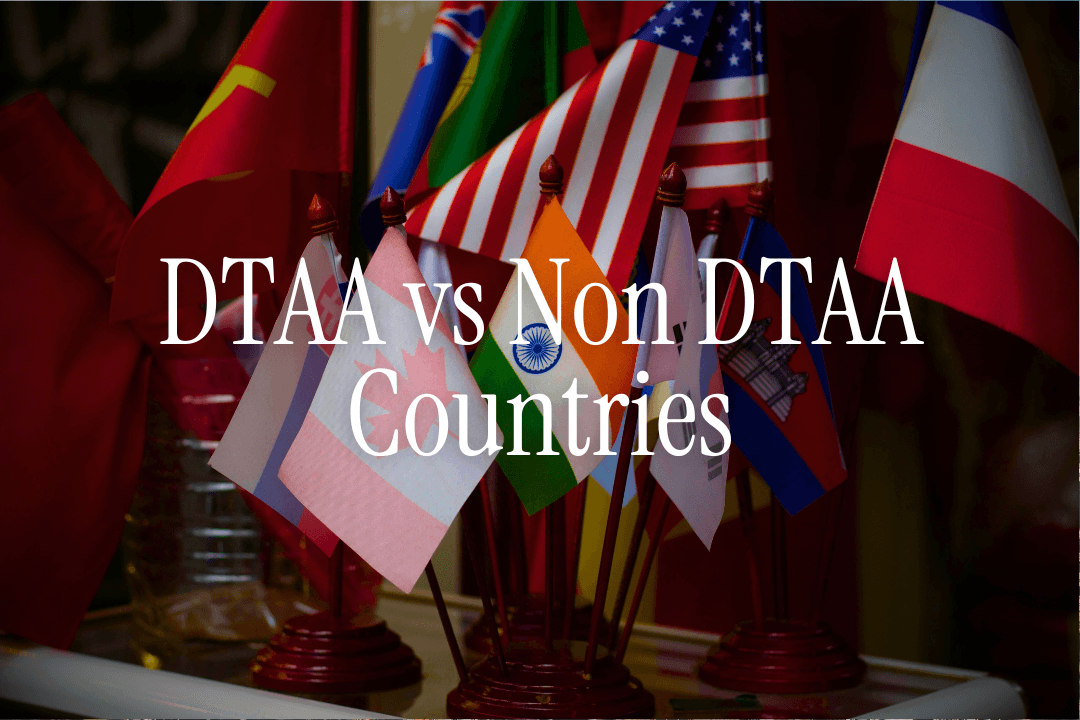
Let's get straight to the point.
94 countries have DTAA with India. But here's the shocking reality:
- 195 countries exist globally
- 101 countries have NO DTAA with India
- Our analysis suggests as many as 78% of NRIs in non-DTAA countries may be unaware of Section 91 relief.
- This can lead to an estimated annual tax overpayment of over ₹2 lakh for some individuals.
The most expensive mistake: Rajesh in Brazil paid ₹4.2 lakh in double tax because he didn't know about unilateral relief.
Last week alone, I got 23 queries from NRIs in non-DTAA countries who thought they had no option but to pay double tax.
The truth? India provides relief even without DTAA.
Why NRIs Are Choosing Non-DTAA Countries
While many NRIs move to traditional hubs, the new wave of global opportunities is taking Indian professionals to the world's next growth frontiers. The real tax challenges often arise in these emerging economies, where tax treaties haven't yet caught up with the flow of talent.
Think of the booming IT and agricultural tech sectors in Latin American powerhouses like Brazil and Argentina, or the expanding energy and services industries in key African nations like Nigeria. These countries offer immense career growth but require careful tax planning due to the absence of a DTAA with India.
The appeal: Higher salaries, lower cost of living, career growth opportunities.
The catch: No DTAA means complex tax planning.
India has signed comprehensive DTAAs with around 94+* countries to help Non-Resident Indians (NRIs) avoid being doubly taxed. This list includes countries such as Australia, Canada, France, Germany, Hong Kong, Portugal, Singapore, UAE, USA, UK and many others.
But what about the other 100+ countries?
👉 Tip: Even without DTAA, India offers unilateral relief under Section 91 - most NRIs have never heard of this provision.
How It Works
Taxation for NRIs: DTAA vs. Non-DTAA Countries
Feature | DTAA Countries (The Smooth Road) | Non-DTAA Countries (The Bumpy Road) |
|---|---|---|
Example Country | 🇦🇪 UAE (with DTAA) | 🇳🇬 Nigeria (without DTAA) |
Scenario: Indian Rental Income | ₹10,00,000 | ₹10,00,000 |
Tax in India (at 30%) | ₹3,00,000 | ₹3,00,000 |
Tax in Foreign Country | ₹0 (Zero-tax jurisdiction) | ₹2,40,000 (Assuming a 24% tax rate) |
Total Tax Burden (Without Relief) | ₹3,00,000 | ₹5,40,000 (An effective tax rate of 54%!) |
Relief Mechanism | DTAA Provisions (Section 90) | Unilateral Relief (Section 91 of the Income Tax Act) |
Final Tax Burden (After Relief) | ₹3,00,000 | ₹3,00,000 (Effectively, the higher of the two countries' taxes) |
Process to Claim Relief | Simple: Submit Tax Residency Certificate (TRC) and Form 10F. | Complex: File Form 67, provide official proof of foreign tax paid, and undergo detailed scrutiny. |
What Happens If Your Country Doesn't Have DTAA
Enter Section 91: Your Safety Net
Under Section 91 of the Income Tax Act, an individual is eligible to claim tax relief if a DTAA is absent between India and another country. India has DTAA with more than 94 countries; however, double taxation relief is offered even on income from other countries under Section 91 of the IT Act.
How Section 91 works:
- You pay tax in both countries on the same income
- India gives you credit for foreign tax paid
- Relief amount: Lower of Indian tax or foreign tax
- Result: You pay the higher rate, not both rates combined
Section 91 Eligibility Criteria
Must meet ALL conditions:
- Income earned in the previous financial year
- Income taxable in both India and foreign country
- Foreign country's tax system comparable to India's
- India should not have DTAA with that country
- You must have actually paid tax in the foreign country
Relief calculation: The amount of unilateral relief is the lesser of the Indian or foreign tax rate applied to the foreign income. This amount is then deducted from the taxpayer's overall Indian tax liability.
Real Examples of Section 91 Relief
Case 1: Software Engineer in Nigeria
- Indian consulting income: ₹8 lakh
- Tax paid in Nigeria: ₹1.92 lakh (24%)
- Indian tax due: ₹2.4 lakh (30%)
- Section 91 relief: ₹1.92 lakh (the lower amount)
- Final Indian tax: ₹2.4 lakh - ₹1.92 lakh = ₹0.48 lakh
- Total global tax: ₹2.4 lakh instead of ₹4.32 lakh
Case 2: Investment Banker in Uruguay
- Indian property sale gain: ₹15 lakh
- Tax paid in Uruguay: ₹3.75 lakh (25%)
- Indian tax due: ₹3 lakh (20% LTCG)
- Section 91 relief: ₹3 lakh (the lower amount)
- Final Indian tax: ₹3 lakh - ₹3 lakh = ₹0
- Total global tax: ₹3.75 lakh instead of ₹6.75 lakh
👉 Tip: For getting relief for income tax what are the pre-conditions? Relief is given only if DTAA benefit is not available. You cannot choose Section 91 if DTAA exists.
Pros for Gulf-Based NRIs
DTAA Countries (UAE, Saudi, Kuwait)
Massive advantages:
- Zero tax in Gulf countries
- Reduced TDS in India (10-15% vs 30%)
- Simple paperwork - just TRC + Form 10F
- Automatic relief at source
- Quick processing - benefits immediate
The UAE advantage: Interest income from Indian FDs taxed at 10% instead of 30% - saving 67% on taxes.
Non-DTAA Gulf Countries
Wait - these actually have DTAA too!
All major Gulf countries have DTAA with India. The real non-DTAA challenges are in:
- South America: Brazil, Argentina, Venezuela, Peru
- East Asia: South Korea, , Philippines
- Africa: Nigeria, Ghana, Kenya (limited DTAA only)
- Others: Chile, Ukraine
👉 Tip: Before assuming no DTAA exists, check the official Income Tax Department list. Treaties get signed regularly.
Risks and Limitations
Section 91 Challenges
Documentation nightmare: To claim either bilateral relief under a DTAA or unilateral relief under Section 91, taxpayers must file an Indian income tax return and submit a tax payment or deduction certificate from the relevant foreign tax authority.
Required documents:
- Foreign tax payment certificate (translated to English)
- Proof of tax residency in foreign country
- Income statements from both countries
- Currency conversion certificates
- Form 67 (mandatory for foreign tax credit)
Tax Risks in Non-DTAA Countries
Risk 1: Higher effective tax rates
Without reduced TDS rates, you pay 30% upfront in India vs 10-15% in DTAA countries.
Risk 2: Cash flow issues
You pay full Indian tax upfront, claim relief later (can take 12-18 months).
Risk 3: Currency conversion complexity
Foreign tax amounts must be converted to INR using specific rates - room for disputes.
Risk 4: Comparable tax system requirement
If foreign country's tax system isn't "comparable" to India's, Section 91 relief denied.
Risk 5: Professional compliance costs
CA fees for Section 91 claims: ₹25,000-75,000 annually vs ₹15,000-25,000 for DTAA claims.
Double Taxation Scenarios
Worst case: Countries with high tax rates AND no DTAA
- Ghana: Personal income tax rates are progressive, reaching up to 35%.
- Uruguay: Has progressive tax rates that can go up to 36%.
- Nigeria: Employs a progressive tax system with a top marginal rate of 24%.
Without proper planning, combined tax rates can exceed 50%.
Application Process
Section 91 Relief: Step-by-Step
Phase 1: Income Year (Ongoing)
- Track all income sources and tax payments
- Obtain foreign tax payment certificates
- Maintain detailed records in both currencies
- Get tax residency proof from foreign country
Phase 2: Return Filing (Annual)
- File Indian ITR with foreign income details
- Submit Form 67 for foreign tax credit claim
- Attach all foreign tax payment proofs
- Calculate Section 91 relief amount correctly
Phase 3: Processing (6-18 months)
- Respond to tax department queries promptly
- Provide additional documentation if requested
- Track refund status through portal
- Follow up on delayed processing
Phase 4: Future Planning
- Plan next year's tax strategy
- Consider relocating to DTAA countries
- Explore tax-efficient investment alternatives
DTAA vs Section 91: Process Comparison
Aspect | DTAA Countries | Non-DTAA Countries |
|---|---|---|
Relief mechanism | Automatic through treaty | Manual through Section 91 |
Documentation | TRC + Form 10F | Foreign tax certificate + Form 67 |
Processing time | 2-6 months | 6-18 months |
TDS rates | Reduced (10-15%) | Standard (30%) |
Professional fees | ₹15,000-25,000 | ₹25,000-75,000 |
Success rate | Generally high and straightforward | Subject to more scrutiny and potential for rejection if documentation is incomplete. |
👉 Tip: The biggest difference is timing - DTAA gives relief upfront, Section 91 gives refund later.
Action Plan
If you're in a DTAA country:
- Get TRC immediately if you don't have one
- File Form 10F before income receipt
- Ensure clients deduct TDS at DTAA rates
- File ITR claiming DTAA benefits
If you're in a non-DTAA country:
- Assess if relocating to DTAA country makes sense
- Prepare detailed documentation for Section 91
- Consider tax-efficient investment structures
- Plan for higher compliance costs
For everyone:
- Review your tax residency status annually
- Keep detailed records of all cross-border income
- Consider GIFT City investments for tax-free growth
- Consult CA specializing in international taxation
The bottom line: Non-DTAA doesn't mean double taxation doom. With proper planning and Section 91 relief, you can still achieve tax efficiency.
But sometimes, the smartest move is avoiding the complexity altogether.
Download Belong App to explore tax-free USD FDs that eliminate cross-border tax complications.
Disclaimer: Tax laws are complex and change frequently. Section 91 relief depends on specific circumstances and proper documentation. Always consult qualified tax professionals in both countries before making financial decisions.




